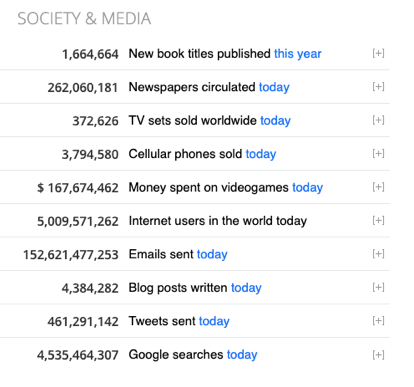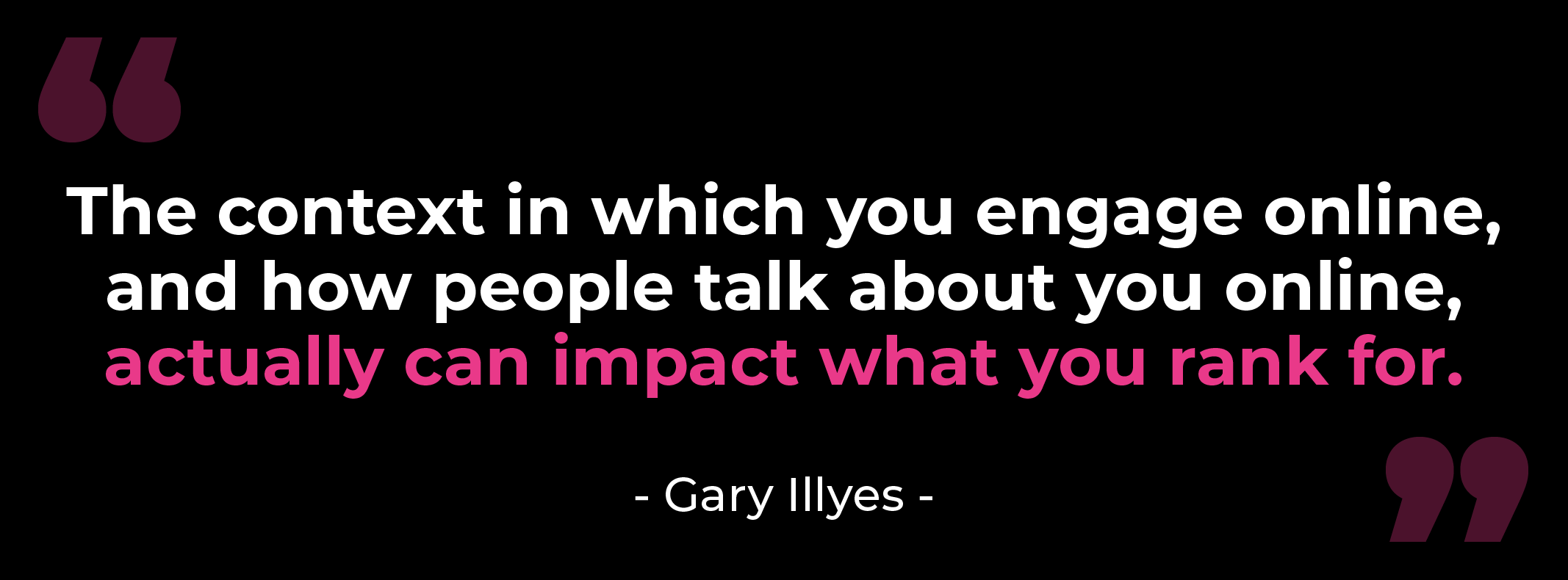Did you know that you can use social media as part of your content strategy to help improve SEO and your Google Search rankings? Yes, your SEO campaign can be boosted through the use of social media.
Tweaking your SEO strategy is vital as it is key to increasing both your Google ranking and your search visibility. However, fierce online competition makes even just appearing on the search results a daily challenge, as more and more content is being published on a daily basis.
For example, data released by WorldOMeter recently revealed that nearly 4.5 million blog posts are published on a daily basis:

With this amount of content being created, published and distributed on a daily basis, the odds of your content showing up on the search engine results are slim. But, Zool can help you improve your chances by creating the right content strategy.
How does social media impact SEO?
Let’s get one thing straight. Social media does not directly contribute to SEO ranking. However, the links that you share on social media do increase your brand exposure, and can influence search engine optimisation in six ways:
- More widespread content distribution
- Longer lifespan for your posts
- Improvement of online visibility and organic traffic
- An increase in brand recognition
- An enhancement of brand reputation
- Boosting local SEO
Also, when people share your content on social media, it also creates social signals that indicate to Google that your target market finds your posts useful.
Research by CognitiveSEO seems to back this up. Their analysis of 23 million social shares seems to show that there is a link between social shares and SEO, with the comments, likes and shares your posts receive being vital signals for search engines when ranking your website.

However, although these sorts of links are helpful of course, Google does not place as much weight on them as links from other authority sites. So, although social media does not have a direct influence on SEO it has a positive impact on search ranking indirectly.
Gary Illyes, Google’s Webmaster Trends Analyst, has also talked about how Google uses online mentions of a brand:

Why is social media important for SEO?
Social media has the potential to drive quality web traffic to your blog and therefore your website as it indirectly influences some of the factors that impact on search rankings.
When you write and publish quality content that engages your target audience, they become advocates for your brand. You are offering them something of value that they will read and share with their friends and followers.
Their followers will then do the same, hopefully, and the content lifecycle will continue.
Whenever we produce any content here at Zool, attracting more eyes to our website is always at the front of our minds. We are not just talking about blog posts though, content also covers:
- Infographics
- Videos
- Webinars
And so on.
Content marketing is essentially sharing valuable information that helps the reader (your target audience). However, this content won’t have any impact if you don’t distribute it properly.
This is where social media comes in. When you share your content on social media, your audience amplifies it by re-sharing it. This increases your brand visibility, improves traffic and helps to generate more backlinks.
Seven social media for SEO best practices to help increase your rankings
Whatever action you take on social media should correspond to your SEO objectives so that you don’t lose traffic on either side.
To find success at using social media for SEO, keep these seven best-practice tips in mind.
Tip One: Focus on quality, not quantity
Google is constantly updating its algorithm in order to better understand user intent and content relevance and quality. Google’s aim is to offer searchers the best answer to their question based on their search query. So, if you want your content to perform well on social media you need to make sure it is helpful and well researched.
Go for quality over quantity. You don’t need to publish a blog post every day. Instead, concentrate on researching your topic and produce more in-depth copy that your readers find interesting. One of the best ways to do this is to really understand your target customer well.
You can also rework old blog content and add more value to them to spike engagement on social media. Also, look for blog posts that are underperforming and add more valuable material to them.
Tip Two: Make sharing your content easy
People use social media for a variety of reasons, but for businesses it is a great way to reach more potential customers with your brand message, thereby growing your brand awareness and generating leads.
However, the only way you are going to be able to get your message out is if you make it easy for your followers to share. Using compelling call-to-action and social share buttons is a great way to do this.
Keep shareability in mind when you are creating social content too. Make headlines and captions compelling, use appealing visuals and ensure content is useful, this way, users will have no choice but to share your post!
Tip Three: Make sure your social media profiles are optimised
It may surprise you to learn that most potential customers will check out your social media profiles before contacting you, in order to get a feel for who you are and what you do.
Therefore, you need to think about how compelling your profile is, whether it has the key elements included that will attract the right people and whether it appears on Google when people search for your business name.
One of the many factors that can negatively impact using social media for SEO is the lack of profile optimisation. This negligence can cost you money as it can prevent your business from appearing on searches across the web.
A well-optimised social media profile helps your target audience to find you online, so it is essential that you have one that is consistent across all channels and aligned with your brand message, blog and website.
Tip Four: Optimise your images for both SEO and social
Visuals are a key part of any marketing communication as they help in developing your brand tone. Also, adding images to your website, blog posts and social media posts is the most effective way to get information across.
Scientific studies have proven that the human brain can process visual information faster than it can process text. According to the Visual Teaching Alliance, our eyes can register 36,000 visual messages per hour, and 90% of all information being transmitted to the brain is visual. Visuals are also processed 60,000 times faster in the brain than text.
In order to make the most of images, you need to ensure they are optimised to make the most of their popularity on social media and in search results. Optimising your images correctly means they will play a vital role in improving your SEO campaign.
Tip Five: Build relationships with your customers through active conversations
One of the best ways to increase engagement on your brand social media accounts is to build relationships with your customers. Relationships between brands and customers not only foster trust but also help to establish credibility. They can also help brands gain a better understanding of their target customers, their needs and the problems they are struggling to solve.
When customers realise that you understand their issues and are trying to help them with those, they are much more likely to engage with you. And the easiest way for them to engage with you is through social media.
You don’t have to wait for customers to engage with you, you can encourage them to do so by
- Asking questions to discover how they feel about you and your brand
- Asking for their thoughts on your latest blog post
- Looking for questions they have already asked and providing them with a useful answer
- Creating a poll to discover more about what they would like to read in your blogs
Tip Six: Craft compelling social media post captions
Whatever industry your business is involved in, the content will play a key role in your marketing strategy. The best content pieces are those that incorporate storytelling.
Investing time in making your post captions compelling to engage users is key. Use enticing snippets of content to hook your readers in, and make them click and share your posts with their tribe.
Also, don’t forget your goal is to improve SEO, so make sure you add your focus keywords and related terms within the captions – in a natural way of course. Also, make sure to use relevant hashtags where possible too.
Tip Seven: Evaluate your social media activities regularly
Your marketing success relies on being able to quantify performance to understand which marketing efforts are working out for you, and which need tweaking.
You need to know whether your social media efforts are generating positive ROI, what is working for you, and what do you need to improve.
You can’t discover if you are successful or not unless you measure things. So, at the start of your social media marketing campaign, we will define the goals of the campaign, and evaluate them on a regular basis to help us (and you) make better marketing decisions and channel our efforts in the right direction.
Conclusion
A robust and sustainable social media strategy is key to improving SEO and helping you to rank higher on the search engine results pages (SERPs). Zool can help you to ensure you are using social media best practices at all times, and keep on top of your performance to identify areas to improve.
Seven Ways Social Media Can Help with SEO
Digital Organic & Paid Social Media SEO / Oct 18, 2021
Did you know that you can use social media as part of your content strategy to help improve SEO and your Google Search rankings? Yes, your SEO campaign can be boosted through the use of social media.
Tweaking your SEO strategy is vital as it is key to increasing both your Google ranking and your search visibility. However, fierce online competition makes even just appearing on the search results a daily challenge, as more and more content is being published on a daily basis.
For example, data released by WorldOMeter recently revealed that nearly 4.5 million blog posts are published on a daily basis:

With this amount of content being created, published and distributed on a daily basis, the odds of your content showing up on the search engine results are slim. But, Zool can help you improve your chances by creating the right content strategy.
How does social media impact SEO?
Let’s get one thing straight. Social media does not directly contribute to SEO ranking. However, the links that you share on social media do increase your brand exposure, and can influence search engine optimisation in six ways:
- More widespread content distribution
- Longer lifespan for your posts
- Improvement of online visibility and organic traffic
- An increase in brand recognition
- An enhancement of brand reputation
- Boosting local SEO
Also, when people share your content on social media, it also creates social signals that indicate to Google that your target market finds your posts useful.
Research by CognitiveSEO seems to back this up. Their analysis of 23 million social shares seems to show that there is a link between social shares and SEO, with the comments, likes and shares your posts receive being vital signals for search engines when ranking your website.

However, although these sorts of links are helpful of course, Google does not place as much weight on them as links from other authority sites. So, although social media does not have a direct influence on SEO it has a positive impact on search ranking indirectly.
Gary Illyes, Google’s Webmaster Trends Analyst, has also talked about how Google uses online mentions of a brand:

Why is social media important for SEO?
Social media has the potential to drive quality web traffic to your blog and therefore your website as it indirectly influences some of the factors that impact on search rankings.
When you write and publish quality content that engages your target audience, they become advocates for your brand. You are offering them something of value that they will read and share with their friends and followers.
Their followers will then do the same, hopefully, and the content lifecycle will continue.
Whenever we produce any content here at Zool, attracting more eyes to our website is always at the front of our minds. We are not just talking about blog posts though, content also covers:
- Infographics
- Videos
- Webinars
And so on.
Content marketing is essentially sharing valuable information that helps the reader (your target audience). However, this content won’t have any impact if you don’t distribute it properly.
This is where social media comes in. When you share your content on social media, your audience amplifies it by re-sharing it. This increases your brand visibility, improves traffic and helps to generate more backlinks.
Seven social media for SEO best practices to help increase your rankings
Whatever action you take on social media should correspond to your SEO objectives so that you don’t lose traffic on either side.
To find success at using social media for SEO, keep these seven best-practice tips in mind.
Tip One: Focus on quality, not quantity
Google is constantly updating its algorithm in order to better understand user intent and content relevance and quality. Google’s aim is to offer searchers the best answer to their question based on their search query. So, if you want your content to perform well on social media you need to make sure it is helpful and well researched.
Go for quality over quantity. You don’t need to publish a blog post every day. Instead, concentrate on researching your topic and produce more in-depth copy that your readers find interesting. One of the best ways to do this is to really understand your target customer well.
You can also rework old blog content and add more value to them to spike engagement on social media. Also, look for blog posts that are underperforming and add more valuable material to them.
Tip Two: Make sharing your content easy
People use social media for a variety of reasons, but for businesses it is a great way to reach more potential customers with your brand message, thereby growing your brand awareness and generating leads.
However, the only way you are going to be able to get your message out is if you make it easy for your followers to share. Using compelling call-to-action and social share buttons is a great way to do this.
Keep shareability in mind when you are creating social content too. Make headlines and captions compelling, use appealing visuals and ensure content is useful, this way, users will have no choice but to share your post!
Tip Three: Make sure your social media profiles are optimised
It may surprise you to learn that most potential customers will check out your social media profiles before contacting you, in order to get a feel for who you are and what you do.
Therefore, you need to think about how compelling your profile is, whether it has the key elements included that will attract the right people and whether it appears on Google when people search for your business name.
One of the many factors that can negatively impact using social media for SEO is the lack of profile optimisation. This negligence can cost you money as it can prevent your business from appearing on searches across the web.
A well-optimised social media profile helps your target audience to find you online, so it is essential that you have one that is consistent across all channels and aligned with your brand message, blog and website.
Tip Four: Optimise your images for both SEO and social
Visuals are a key part of any marketing communication as they help in developing your brand tone. Also, adding images to your website, blog posts and social media posts is the most effective way to get information across.
Scientific studies have proven that the human brain can process visual information faster than it can process text. According to the Visual Teaching Alliance, our eyes can register 36,000 visual messages per hour, and 90% of all information being transmitted to the brain is visual. Visuals are also processed 60,000 times faster in the brain than text.
In order to make the most of images, you need to ensure they are optimised to make the most of their popularity on social media and in search results. Optimising your images correctly means they will play a vital role in improving your SEO campaign.
Tip Five: Build relationships with your customers through active conversations
One of the best ways to increase engagement on your brand social media accounts is to build relationships with your customers. Relationships between brands and customers not only foster trust but also help to establish credibility. They can also help brands gain a better understanding of their target customers, their needs and the problems they are struggling to solve.
When customers realise that you understand their issues and are trying to help them with those, they are much more likely to engage with you. And the easiest way for them to engage with you is through social media.
You don’t have to wait for customers to engage with you, you can encourage them to do so by
- Asking questions to discover how they feel about you and your brand
- Asking for their thoughts on your latest blog post
- Looking for questions they have already asked and providing them with a useful answer
- Creating a poll to discover more about what they would like to read in your blogs
Tip Six: Craft compelling social media post captions
Whatever industry your business is involved in, the content will play a key role in your marketing strategy. The best content pieces are those that incorporate storytelling.
Investing time in making your post captions compelling to engage users is key. Use enticing snippets of content to hook your readers in, and make them click and share your posts with their tribe.
Also, don’t forget your goal is to improve SEO, so make sure you add your focus keywords and related terms within the captions – in a natural way of course. Also, make sure to use relevant hashtags where possible too.
Tip Seven: Evaluate your social media activities regularly
Your marketing success relies on being able to quantify performance to understand which marketing efforts are working out for you, and which need tweaking.
You need to know whether your social media efforts are generating positive ROI, what is working for you, and what do you need to improve.
You can’t discover if you are successful or not unless you measure things. So, at the start of your social media marketing campaign, we will define the goals of the campaign, and evaluate them on a regular basis to help us (and you) make better marketing decisions and channel our efforts in the right direction.
Conclusion
A robust and sustainable social media strategy is key to improving SEO and helping you to rank higher on the search engine results pages (SERPs). Zool can help you to ensure you are using social media best practices at all times, and keep on top of your performance to identify areas to improve.
Array
